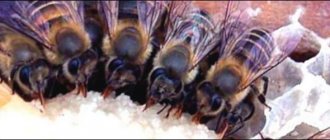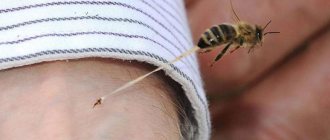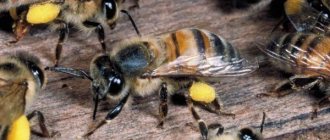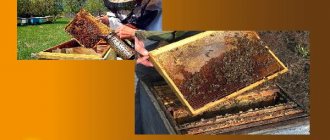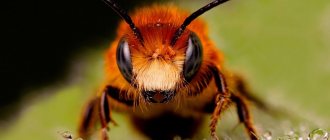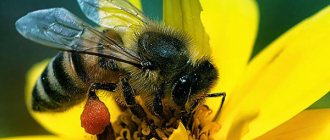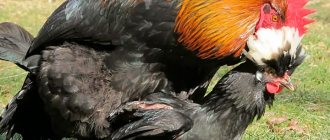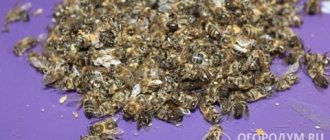When does winter start?
Preparation for cold weather starts in mid-autumn. Bees store honey and nectar in the top combs of the hive and seal them to prevent fermentation. After that, it’s time to expel the drones: this will save supplies and survive the winter. First, they are driven to the bottom of the hive, where the drones, deprived of food, quickly lose strength. Then the bees throw them out of the hive and they die.
Then the insulation of the home begins. Insects cover cracks and openings in the hive with propolis to avoid drafts and hypothermia. They carry out general cleaning, freeing the home from garbage. The activity gradually weakens: this means that soon the processes will finally slow down and the bees will officially be ready for the cold weather.
What else do bees do at night?
If you quietly approach the hive at night, you get the impression that the bees are not sleeping. If you listen closely, you can hear the quiet, monotonous hum of thousands of bees. Work in the hive is in full swing around the clock. You can hear the rustling of bees as they build honeycombs. Each age group of bees strictly performs its functions. At night, those individuals that enter the queen’s retinue feed her, lick the uterine substance from her and pass it on to other family members.
Young bees, in the first 2 weeks of life, are considered flightless and work inside the hive. They clean the cells, heat and feed the brood, build honeycombs, take in pollen and nectar, and process them into honey. Young bees collect pollen brought by worker bees and pack it tightly into the cells, adding honey. Periodically, they monitor the larvae in the cells to see if they need food. These hardworking insects can cover a distance of about 2.5 meters in a day without sleep or rest.
Bees also evaporate moisture from nectar brought by worker bees. To prevent the nectar from fermenting, bees remove excess moisture from it by actively ventilating it with their wings. They can ventilate during the day, but the main work is done at night. One group of bees removes air from the hive by flapping their wings, the other brings in clean air. On summer nights after a day's honey collection, you can clearly hear the hum of the hives and the honey aroma that comes from the entrances.
Bees guard their hive at night, since many nocturnal insects want to feast on sweet honey. Basically, these insects protect their hive from their fellows, since theft is common among bees. Bees must get food and it doesn’t matter how they do it. Some bees may rob a neighboring, weaker bee colony if given the opportunity.
The bee world is a wonderful world. You can learn a lot and learn a lot by watching them. Looking at the work of these hardworking insects, you can’t help but admire how they work hard, take care of their family, selflessly protect their hive and are ready to give their lives even if there is a minor threat to their family.
Wintering
How bees spend the winter depends on whether they are domestic or wild. In nature, insects have great endurance compared to those raised by humans. They are able to withstand extremely low temperatures - down to -50 degrees Celsius. The main condition for their survival in winter conditions is the presence of a sufficient amount of honey. If there is too little of it, the bees will not be able to feed themselves and have virtually no chance of surviving. Comfortable habitats are tree hollows. There, wild bees huddle together in a tight ball, which helps maintain a comfortable temperature.
Domesticated bees overwinter in much the same way. In the cold season, they can live in a winter hut (omshanik) or on the street. In each case, the beekeeper needs to monitor their well-being and provide care.
General principles:
- Minimum noise, light, vibration . Bees spend the winter in darkness and silence. Bright daylight will disturb them or make them think it is already spring. If they crawl out, mortality will begin.
- Maintaining an optimal microclimate . Insects do not like drafts, but prefer good ventilation. Heat can be more dangerous for them than hypothermia.
- Calming measures . If one bee colony becomes disturbed, it will disturb the others. The beekeeper must know how to pacify his charges.
Do bees fly at night?
Bees sometimes fly at night, but only if there is a need for it. They don't do unnecessary things at all. It may also be that bees do not fly during the day, but at night they rush to honey plants. The darkness does not frighten these insects, since they navigate not only by the sun, but also by the electromagnetic field of the earth. It happens that bees return to the hive long after midnight. Bees do not fly at night due to a lack of expediency, which is associated with the condition of the honey plants. There are night honey plants with their own aroma and color spectrum. Such plants usually bloom in the early morning. These flowers include jasmine, night violets, curly lilies and some others. Raspberries produce nectar around the clock and even in cold summer, so you can often find honey plants on this plant at night. During the period of good nectar production, bees can stay in the field overnight. And early in the morning at sunrise they fly into the hive, loaded with nectar.
Another reason why these little creatures rarely fly at night is the decrease in the magnetic field. A reduced magnetic field leads to a disturbance in the orientation of these insects. It is for this reason that bees do not fly during magnetic storms, solar and lunar eclipses and other natural disasters. In addition to the magnetic field, bees also rely on the electric field of the area. Around 10 p.m. the electric charge decreases several times, and at about 3 a.m. it disappears completely. This is another reason why bees rarely fly at night or not at all.
Do insects sleep?
Many beekeepers are interested in whether bees sleep in winter. The correct answer is no, they do not hibernate like most insects. Their metabolic processes slow down and activity decreases. They fall into a sluggish, inert state, huddled in one large pile - a ball of bees - at the bottom of the hive, where the warmest place is. This way they maintain comfortable temperature conditions. If the bees freeze, they begin to move more actively, generating energy. As soon as it gets warmer, activity drops again.
This continues until spring, until they feel a general increase in external temperature. To check whether winter is over, “scouts” are sent.
When asked what bees eat in winter, the answer is obvious: they feed on honey and sugar syrup. They make their own food supplies. If the family is healthy, no additional feeding is required: they will prepare the required amount of food themselves. During the entire winter, bees almost never defecate: the body allows them to accumulate large reserves of feces. The main condition is the quality of honey. If it goes bad, the whole family could die.
The more comfortable the conditions in the hive and the healthier the bee colony, the less food they will eat during the winter.
Communications and characteristics of bees
Honey bee.
Honey bees, which live in families, have a clear hierarchy. There is a queen bee, the main bee, who is the founder of the family, and worker bees. There are also drones, annual individuals.
It seems that the most important one is the founder, because she lays eggs and regulates the behavior of animals. But workers are responsible for the entire hive, and if necessary, they can also feed a new queen.
Device
The large colony is structured in a very unusual and correct way; they have their own organization. They know how to dance and thereby convey information about the power source.
Peculiarities
Bees also have reflexes, which has already been tested and confirmed scientifically. They have their own smell, characteristic of the family and the uterus.
Character
Bees are peaceful; if in nature there are different species or several individuals from different hives, they do not fight. But one bee, if it wanders into someone else's hive, will be expelled.
Lifespan
The lifespan of one worker honey bee is 2-3 months, for those born in the fall – up to 6 months. The uterus lives for about 5 years.
The tasks of a beekeeper when wintering bees in an omshanik
When organizing wintering indoors, beekeepers sometimes bring hives into the basement, barn or attic. Such rooms do not always have insulation, and for the bees to feel comfortable, it is desirable to maintain a constant temperature. In severe frosts they will freeze, and additional insulation of the hive will be required.
The best option would be an omshanik or a winter shelter. The room temperature should be maintained within +4-6 degrees for open hives and from 0 to +3 for closed ones. Some beekeepers believe that temperatures just below zero will not harm insects. You can tell if they are hot by the sounds they make: if the buzzing is smooth, quiet and monotonous, everything is in order, if it is loud, they may need coolness.
If the family starts to worry, you can take it outside and open the entrance. It is worth returning to the winter hut only after the insects have calmed down. Otherwise they will disturb the others. If this does happen, it is necessary to cool the omshanik room.
Another important condition is maintaining peace and quiet. This way the bees will not become alarmed and start leaving the hive ahead of time. You can scatter sawdust or sand around the omshanik to muffle the sound of footsteps. They enter the room carefully, quietly, without using bright lamps and lanterns - the best option would be lamps of red color, indistinguishable by bees.
Do bees sleep at night?
There has been debate for a long time whether bees sleep or not. Some evidence suggests that they do not sleep and eventually die from exhaustion. There is some truth and untruth in this. Studies of the life period of bees have shown that there are periods, both day and night, for several seconds, when the bees stopped responding to external factors, their antennae lowered, their bodies relaxed.
Young individuals do not have any routine, while older individuals, on the contrary, have a more regular routine. These short periods of falling asleep are the short periods of rest that young honey bearers can afford. In the period from 3 to 6 weeks after the first flight of the bees, they literally collapse from fatigue.
Wintering outside
The method allows you to breed a healthier and more resilient generation. Although many people are surprised by how bees spend the winter outside and still survive in cold weather conditions, there is nothing complicated about it.
To overwinter insects outside, it is necessary to carefully insulate the hives in the northern regions. Suitable materials include polystyrene foam, foil, and warm soft fabric. It is better to avoid padding polyester - they can get entangled in it.
The hives are placed near the southern wall of the building. If the space is open, then slate fences are installed to protect from winds.
The entrances should be left open. If they freeze in frost, it’s okay: you can clean them during the thaw.
Benefits of sleep for bees
People sleep in order to restore strength and gain new ones. Without proper rest, the body wears out much faster, vital processes slow down and occur incorrectly.
Bee on vacation.
Experiments that were carried out on the reaction of bees to lack of sleep led to results that surprised everyone. Insects suffer greatly without rest:
- The dance movements were slow and irregular.
- We lost our way and spent a long time looking for a source of food.
- They even lost members of their own family.
- They even see dreams that come with knowledge.
Causes of death of bees in winter
The death of individuals is influenced by various factors, some of which are the result of improper preparation for wintering. Main reasons:
- increased humidity inside - due to poor ventilation in the room or improper processing during preparation;
- souring or sugaring of honey, bee bread, which leads to hunger;
- lack of food due to cold;
- bee diarrhea - lack of flight during late brood, which leads to the accumulation of feces in young animals (the disease affects the entire family);
- absence of a queen - due to the search for the “queen” the club begins to break up;
- bright light, high temperature, noise;
- hunger due to low temperature - death in the form of a slide;
- diseases - salmonellosis, viral paralysis, larval rot.
To prevent the death of the “wards”, it is necessary to comply with the rules for arranging comfortable conditions for wintering. The main thing is to maintain humidity and temperature within optimal limits, provide sufficient food, and insulate the room.
Where do bees spend the winter?
Bees, contrary to expectations, do not sleep in winter. They gather in a ball, which helps keep each other warm. Metabolic processes slow down and the amount of feed consumed decreases. This causes rare bowel emptying. Inactivity is a factor that helps maintain the strength required to survive in the cold season.
A question that requires clarification is where do domestic bees usually spend the winter? There are two common options:
- a well-insulated room (omshanik, cellar, barn) - winter hut;
- street - houses for insects remain in the apiary.
Under natural conditions, bee colonies tolerate cold well and remain viable by organizing nests in tree hollows. Beekeepers practice a similar method and leave the insects in the wild. The main thing is to equip the hives with insulation. The wintering period begins in November and lasts until April.
